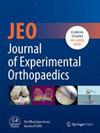Enhanced early rehabilitation and pain management with all-arthroscopic medial patellofemoral ligament reconstruction: A comparative study
Abstract
Purpose
The purpose of this study was to evaluate the accuracy of femoral tunnel location, post-operative pain management, functional rehabilitation and clinical outcomes in medial patellofemoral ligament (MPFL) reconstruction using all-arthroscopic technique.
Methods
Between 2020 and 2021, 160 patients with recurrent patellar dislocation undergoing MPFL reconstruction were categorized into control (traditional surgery) and study (all-arthroscopic technique) groups. Femoral tunnel accuracy was assessed via computed tomography scans, pain management, functional rehabilitation, knee range of motion and daily activities were evaluated up to 6 months post-operatively. Knee function was assessed using Kujala and Lysholm scores at post-operative 12 months.
Results
Seventy-one patients in the control group and 69 patients in the study group reached the final follow-up with no demographic differences. Follow-up duration was 12.65 ± 0.68 vs 12.77 ± 0.73 months in the control and study groups (p = 0.3145). The intra-class correlation coefficient was excellent (r = 0.97). In femoral tunnels, 93.5% in the control group and 92.4% in the study group were correctly localized. In patellar tunnels, 96.1% in the control group and 96.2% in the study group were correctly localized (p > 0.9999). Post-operative strong opioid analgesics were used 25.9 ± 31.0 versus 12.0 ± 22.2 mg/day in the control and study groups (p = 0.0016). The pain score was 3.4 ± 1.1 versus 2.7 ± 1.2 in the control and study groups (p = 0.0006) during post-operative functional rehabilitation. Time to resume daily living was 8.2 ± 0.6 versus 7.6 ± 0.6 weeks in the control and study groups (p < 0.0001). Time to resume low-intensity exercise was 12.3 ± 0.6 versus 11.7 ± 0.6 weeks in the control and study groups (p < 0.0001). In the more than 1-year follow-up, no significant difference was found in the Kujala and Lysholm scores.
Conclusions
The all-arthroscopic technique for MPFL reconstruction in recurrent patellar dislocation ensures precise femoral tunnel placement. It offers advantages in early post-operative pain management and functional recovery, enabling faster rehabilitation compared to traditional non-all-arthroscopic techniques.
Level of Evidence
Level III.


 求助内容:
求助内容: 应助结果提醒方式:
应助结果提醒方式:


